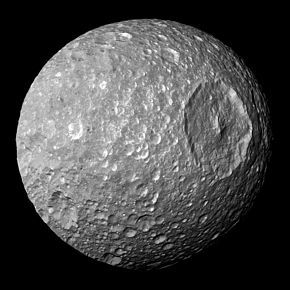
Back Mimas (maan) Afrikaans ميماس Arabic میماس (قمر) AZB Мімас (спадарожнік) Byelorussian Мімас (спадарожнік) BE-X-OLD Мимас (спътник) Bulgarian Mimas (satèl·lit) Catalan Mimas (ôi-sĭng) CDO میماس (مانگ) CKB Mimas Corsican
 | |
| Discovery | |
|---|---|
| Discovered by | William Herschel |
| Discovery date | 17 September 1789[1] |
| Designations | |
Designation | Saturn I |
| Pronunciation | /ˈmaɪməs/[2] or as Greco-Latin Mimas (approximated /ˈmiːməs/) |
Named after | Μίμας Mimās |
| Adjectives | Mimantean,[3] Mimantian[4] (both /mɪˈmæntiən/) |
| Orbital characteristics [5] | |
| Periapsis | 181902 km |
| Apoapsis | 189176 km |
| 185539 km | |
| Eccentricity | 0.0196 |
| 0.942421959 d | |
Average orbital speed | 14.28 km/s (calculated) |
| Inclination | 1.574° (to Saturn's equator) |
| Satellite of | Saturn |
| Physical characteristics | |
| Dimensions | 415.6 × 393.4 × 381.2 km (0.0311 Earths)[6] |
| 198.2±0.4 km[6][7] | |
| 490000–500000 km2 | |
| Volume | 32600000±200000 km3 |
| Mass | (3.75094±0.00023)×1019 kg [7] (6.3×10−6 Earths) |
Mean density | 1.1501±0.0070 g/cm3[7] |
| 0.064 m/s2 (0.00648 g) | |
| 0.159 km/s | |
| synchronous | |
| zero | |
| Albedo | 0.962±0.004 (geometric)[8] |
| Temperature | ≈ 64 K |
| 12.9 [9] | |
Mimas, also designated Saturn I, is the seventh-largest natural satellite of Saturn. With a mean diameter of 396.4 kilometres or 246.3 miles, Mimas is the smallest astronomical body known to be roughly rounded in shape due to its own gravity. Mimas's low density, 1.15 g/cm3, indicates that it is composed mostly of water ice with only a small amount of rock, and study of Mimas's motion suggests that it may have a liquid ocean beneath its surface ice. The surface of Mimas is heavily cratered and shows little signs of recent geological activity. A notable feature of Mimas's surface is Herschel, one of the largest craters relative to the size of the parent body in the Solar System. Herschel measures 139 kilometres (86 miles) across, about one-third of Mimas's mean diameter,[10] and formed from an extremely energetic impact event. The crater's name is derived from the discoverer of Mimas, William Herschel, in 1789. The moon's presence has created one of the largest 'gaps' in Saturn's ring, named the Cassini Division, due to orbital resonance destabilizing the particles' orbit there.
- ^ Cite error: The named reference
CosmoVisionswas invoked but never defined (see the help page). - ^ "Mimas". Merriam-Webster.com Dictionary.
- ^ "JPL (2009) Cassini Equinox Mission: Mimas". Archived from the original on 2009-04-06. Retrieved 2009-04-06.
- ^ Harrison (1908) Prolegomena to the study of Greek religion, ed. 2, p. 514
- ^ Cite error: The named reference
Harvey2007was invoked but never defined (see the help page). - ^ a b Cite error: The named reference
Roatsch2009was invoked but never defined (see the help page). - ^ a b c Jacobson, Robert. A. (1 November 2022). "The Orbits of the Main Saturnian Satellites, the Saturnian System Gravity Field, and the Orientation of Saturn's Pole*". The Astronomical Journal. 164 (5): 199. Bibcode:2022AJ....164..199J. doi:10.3847/1538-3881/ac90c9. S2CID 252992162.
- ^ Cite error: The named reference
Verbiscer2007was invoked but never defined (see the help page). - ^ Cite error: The named reference
Observatorio ARVALwas invoked but never defined (see the help page). - ^ "Herschel". Gazetteer of Planetary Nomenclature. USGS Astrogeology Research Program.
© MMXXIII Rich X Search. We shall prevail. All rights reserved. Rich X Search